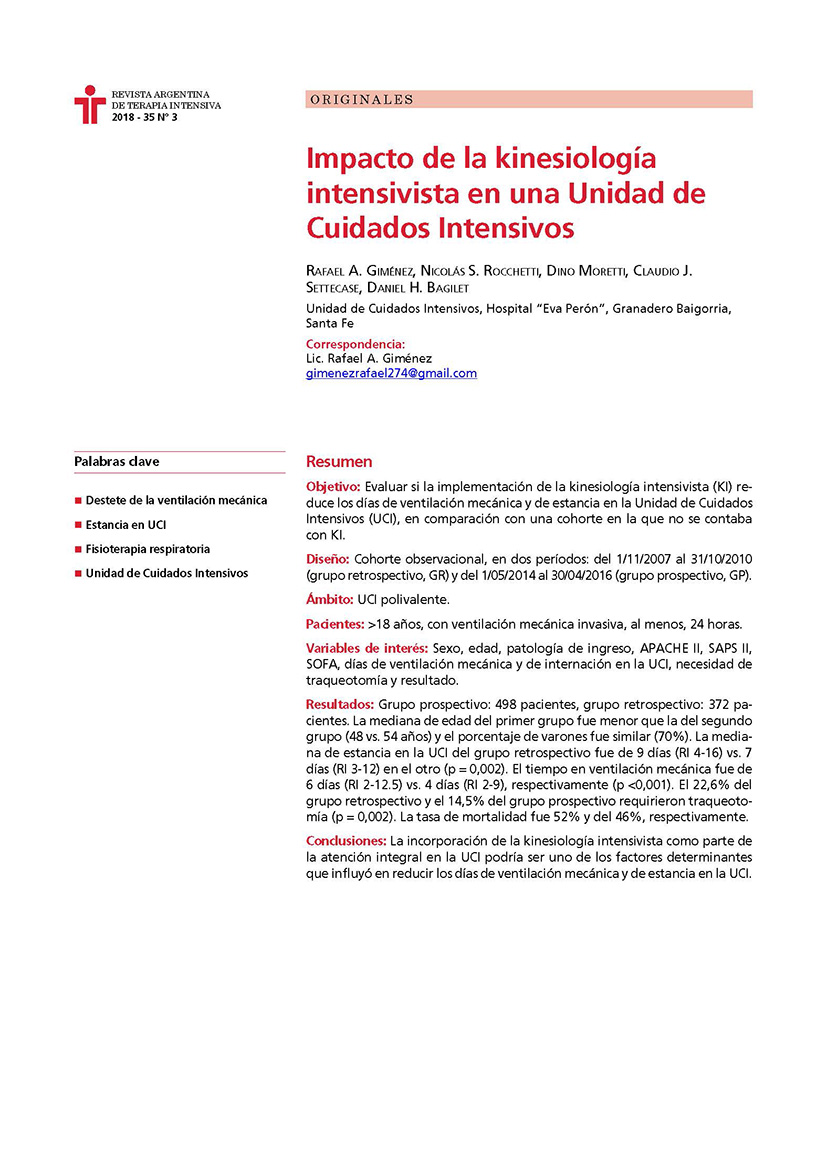Resumen
OBJETIVO: Evaluar si la implementación de la kinesiología especializada en cuidados críticos (KECC) reduce los días de ventilación mecánica (VM) y de estancia en UCI, en comparación con una cohorte en la que no se contaba con KECC.
DISEÑO: Cohorte observacional, en dos períodos de tiempo entre el 01/11/2007 y el 31/10/2010 (grupo retrospectivo, GR), y desde el 01/05/2014 al 30/04/2016 (grupo prospectivo, GP).
ÁMBITO: UCI polivalente.
PACIENTES: > 18 años, con VM invasiva al menos 24 horas.
VARIABLES DE INTERÉS: sexo, edad, patología de ingreso, APACHE II, SAPS II, SOFA, días estancia en VM y de internación en UCI, necesidad de traqueotomía y resultado.
RESULTADOS: 498 conformaron el GP y 372 el GR. La mediana de edad del GP fue menor que en el GR (48 vs. 54 años) y el porcentaje de varones fue similar (70%). La mediana de estancia en UCI del GR fue de 9 días (RI 4; 16) vs. 7 días (RI 3; 12) en el GP (p=0,002). Mientras que la de estancia en VM en el GR fue de 6 días (RI 2; 12,5) vs. 4 días (RI 2; 9) en el GP (p<0,001). Requirieron traqueotomía el 22,6% en el GR y 14,5% en el GP (p=0,002). La mortalidad del GP fue del 46% vs. 52% en el GR.
CONCLUSIONES: La incorporación de la KECC como parte de la atención integral en la UCI podría ser uno de los factores determinantes que influyó en reducir los días de VM y de estancia en UCI.Referencias
Goldhill DR, Badacsonyi A, Goldhill AA, Waldmann C. A prospective observational study of ICU patient position and frequency of turning. Anaesthesia. 2008;63(5):509-15.
Needham DM. Mobilizing patients in the intensive care unit: improving neuromuscular weakness and physical function. JAMA. 2008;300(14):1685-90.
De Jonghe B, Sharshar T, Lefaucheur JP, Authier FJ, Durand-Zaleski I, Boussarsar M, et al. Paresis acquired in the intensive care unit: a prospective multicenter study. JAMA. 2002;288(22):2859-67.
de Letter MA, Schmitz PI, Visser LH, Verheul FA, Schellens RL, Op de Coul DA, et al. Risk factors for the development of polyneuropathy and myopathy in critically ill patients. Crit Care Med. 2001;29(12):2281-6.
De Jonghe B, Bastuji-Garin S, Sharshar T, Outin H, Brochard L. Does ICU-acquired paresis lengthen weaning from mechanical ventilation? Intensive Care Med. 2004;30(6):1117-21.
Castro AA, Calil SR, Freitas SA, Oliveira AB, Porto EF. Chest physiotherapy effectiveness to reduce hospitalization and mechanical ventilation length of stay, pulmonary infection rate and mortality in ICU patients. Respir Med. 2013;107(1):68-74.
Burtin C, Clerckx B, Robbeets C, Ferdinande P, Langer D, Troosters T, et al. Early exercise in critically ill patients enhances short-term functional recovery. Crit Care Med. 2009;37(9):2499-505.
Stiller K. Physiotherapy in intensive care: an updated systematic review. Chest. 2013;144(3):825-47.
Conti EJ. [Kinesiology survey Respiratory: Current situation In Argentina]. Rev Am Med Resp. 2009; 9:14-20.
Ely EW, Baker AM, Dunagan DP, Burke HL, Smith AC, Kelly PT, et al. Effect on the duration of mechanical ventilation of identifying patients capable of breathing spontaneously. N Engl J Med. 1996;335(25):1864-9.
Branson RD. Secretion management in the mechanically ventilated patient. Respir Care. 2007;52(10):1328-42; discussion 42-7.
Norrenberg M, Vincent JL. A profile of European intensive care unit physiotherapists. European Society of Intensive Care Medicine. Intensive Care Med. 2000;26(7):988-94.
Chaboyer W, Gass E, Foster M. Patterns of chest physiotherapy in Australian Intensive Care Units. J Crit Care. 2004;19(3):145-51.
Quintana R, Ottone C, Bagilet DH, Settecase C, Quaglino MB. [General characteristics and predictive factors of hospital mortality in patients with mechanical ventilatory assistance]. Medicina Intensiva. 2012;29(4).
Larsen MS, Jorgensen HR. [Mortality among victims of traffic accidents with multiple injuries. A descriptive study 1986-1990]. Ugeskr Laeger. 1995;157(48):6716-9.
Akgul Karadana G, Metin Aksu N, Akkas M, Akman C, Uzumcugil A, Ozmen MM. The epidemiology and cost analysis of patients presented to Emergency Department following traffic accidents. Med Sci Monit. 2013;19:1125-30.
Ubeda C, Espitia-Hardeman V, Bhalla K, Borse NN, Abraham JP, Dellinger A, et al. National burden of road traffic injuries in Argentina. Int J Inj Contr Saf Promot. 2012;19(1):9-18.
Mas N, Olaechea P, Palomar M, Alvarez-Lerma F, Rivas R, Nuvials X, et al. [Comparative analysis of patients admitted to Spanish Intensive Care Units due to medical and surgical disease]. Med Intensiva. 2015;39(5):279-89.
Valentin A, Ferdinande P, Improvement EWGoQ. Recommendations on basic requirements for intensive care units: structural and organizational aspects. Intensive Care Med. 2011;37(10):1575-87.
La revista no retiene los derechos de reproducción (copyright) por lo que los autores pueden volver a publicar sus trabajos con la sola mención a la fuente original de publicación.

